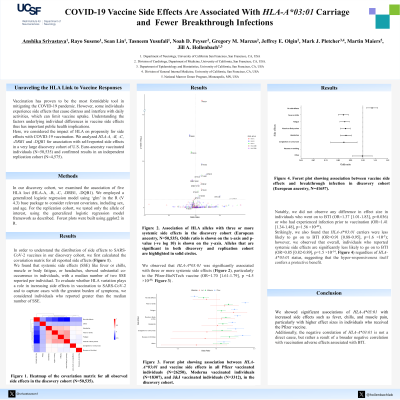Back

COVID-19 Vaccine Side Effects Are Associated With HLA-A*03:01 Carriage and Fewer Breakthrough Infections
(P515) COVID-19 vaccine side effects are associated with HLA-A*03
Location: Platinum Ballroom

Poster Presenter(s)
Body: Vaccination has proven to be the most formidable tool in mitigating the COVID-19 pandemic. However, some individuals experience side effects that cause distress and interfere with daily activities, which can limit vaccine uptake. Understanding the factors underlying individual differences in vaccine side effects thus has important public health implications. We previously demonstrated that HLA variation is associated with asymptomatic disease course in SARS-CoV-2 infection. Here, we considered the impact of HLA on propensity for side effects with COVID-19 vaccination. We analyzed HLA-A, -B, -C, -DRB1 and -DQB1 for association with self-reported side effects in a very large discovery cohort of U.S. Euro-ancestry vaccinated individuals (N=50,535) and confirmed results in an independent replication cohort (N=4,575). HLA-A*03:01 was significantly associated with systemic side effects, particularly to the Pfizer-BioNTech vaccine (OR=1.70 [1.61-1.79], p<0.001). Notably, we observed a comparatively lesser effect size in individuals who went on to breakthrough infections (OR=1.43 [1.35-1.51], p<0.001) or who had experienced infection prior to vaccination (OR=1.40 [1.34-1.48], p<0.001). Strikingly, we found that HLA-A*03:01 carriers were less likely to go on to breakthrough infections (OR=0.91 [0.88-0.95], p<0.001); however we observed that overall, individuals who reported systemic side effects are significantly less likely to go on to breakthrough infection (OR~0.85 [0.82-0.89], p=0.001) regardless of HLA-A*03:01 status, suggesting that the hyper-responsiveness itself confers a protective benefit. Our findings regarding the role of HLA-mediated side effects in COVID-19 vaccination and the associated evidence for protection from subsequent infection may inform efforts toward improved vaccine efficacy and increased public participation in vaccination programs.
Conclusion: In this study, we showed COVID-19 vaccine side effects are associated with a HLA polymorphism (HLA-A*03:01) and fewer breakthrough infections in Caucasians from two different datasets.
Conclusion: In this study, we showed COVID-19 vaccine side effects are associated with a HLA polymorphism (HLA-A*03:01) and fewer breakthrough infections in Caucasians from two different datasets.

